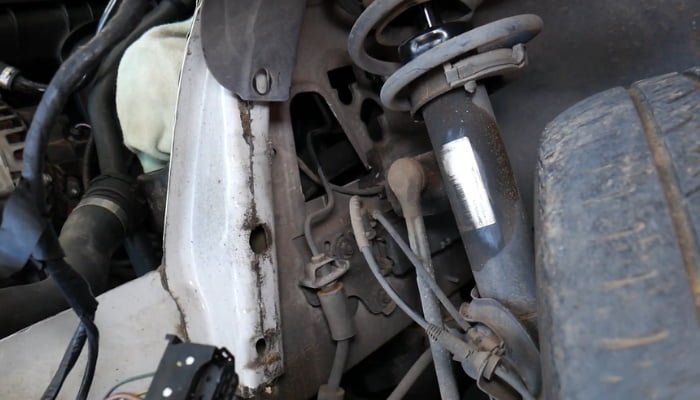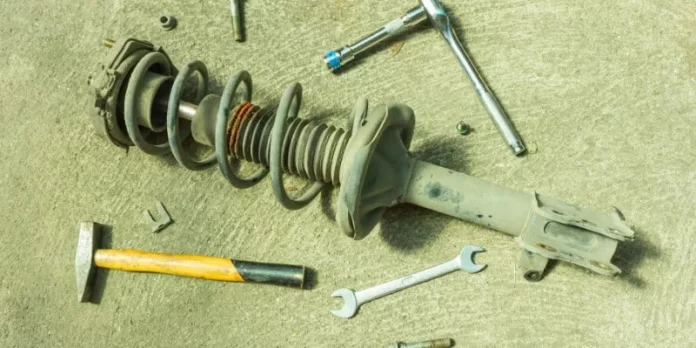Last updated on February 1st, 2024
Knowing when a strut is bad is important to maintaining a safe and comfortable driving experience. Struts are an integral part of a vehicle’s suspension system and play a key role in keeping your car stable and in contact with the road.
When a strut is bad, it can lead to a number of issues, including decreased handling, increased tire wear, and even safety concerns.
Fortunately, there are a few telltale signs that can help you determine if a strut is bad, and when it’s time to replace it.
By understanding the signs of a bad strut and how to check for them, you will ensure your car’s suspension remains in top condition and keep yourself safe on the road.
What Does a Bad Strut Sound Like?
A failed strut mount can make all sorts of strange noises – from clunking and knocking to creaking and grinding.
These sounds are usually more noticeable when driving over speed bumps or potholes, on uneven terrain, or at slow speeds while rotating the wheels all the way to the stops.
If your tire is rubbing against the strut, there can also be a humming sound.


Bad Strut Symptoms
Effective struts increase your safety while driving and help prevent damage to other components of your car. Keep an eye out for these warning signals that suggest it may be time to check and replace your shocks and struts.
Knocking Sound When Driving Over a Bump
A knocking noise coming from your car’s front end is a sign that your strut is defective. The internal strut parts, including the shock absorbers and bushings, can wear out over time and contribute to the noise.
If you hear this weird noise near the front of your car, it’s time to conduct a professional examination of your struts.
Clicking Noise When Steering
If you hear a clicking noise from the front of your car when turning corners, it may be a sign that the top mount bearing or the coil spring of the strut is damaged.
However, since the rear has no top mount bearing and there is no steering in the back, the spring will not travel in that direction, so it will only affect the front struts.
Bumpy Ride
If your car bounces a lot while you drive, it’s possible that your front or rear shocks or strut is broken.
However, a bumpy ride isn’t always indicative of failing shock absorbers. The deterioration of other suspension parts, like bushings, can also cause a rougher ride.
Because of this, it’s generally best to have your car inspected by a reliable mechanic.
Unstable Car
A floating front end is a symptom of a faulty front strut. Your car might sway to one side if the front end is floating.
This can be dangerous at high speeds, not just for you but also for other drivers. If you notice this sign, the first thing you should do is inspect your car’s alignment.
Uneven Tire Wear
Uneven tire wear is an uncommon sign that your struts might be damaged. This may happen if the coil spring snaps, which would lower your vehicle and shift the wheel alignment.
Therefore, if you detect any uneven tire wear, it’s important to inspect your suspension struts and, after replacing the struts, make sure to do a new wheel alignment.
Car Height Tilts on One Side
If the coil spring in your car’s struts breaks, it can cause your car to lean to one side. This is because the spring will shorten, resulting in a height difference between the tire and the fender.
You may not notice this right away, as the height difference is usually quite small.
However, if you compare the distance between the tire and the fender on both sides of the car, you should be able to detect a difference.
How To Know If Your Struts Are Bad
Worn-out struts on your car can be extremely uncomfortable and can lead to problems like a cacophony of noises and rough rides.
Furthermore, struts that are much past their expiration date may result in issues that compromise your vehicle’s safety.
Major signs of a bad strut include;
- The nose of your car dipping when you brake
- Bounciness on rocky surfaces
- Crosswinds causing your car to swerve
- Extreme sways or leans when turning
- A trembling steering wheels
- Premature or uneven tire wear
- Apparent fluid leaks
- Your car’s height being tilted on one side
- Unusual noises while driving
What Does a Bad Strut Look Like?
A damaged strut doesn’t actually appear different from a functioning strut, but you can tell the distinction between the two by observing how they react to pressure.
When force or pressure is applied to a good strut, it will respond as predicted; in contrast, a lousy strut will either respond slowly or not at all.
Can You Drive with Bad Struts?
Theoretically, faulty struts don’t stop you from driving your car. However, they impair vehicle safety and make your car difficult to control, so you must take extreme caution if you must drive in this condition.
When driving with faulty struts, your wheels are the first parts that could be harmed.
Since wheels and tires are a component of the suspension system, defective struts might result in a flat tire or damage to the wheels, which can cause an accident.
A broken strut or two will also have an impact on your car’s joints.
As the joints weaken and eventually break from vibrations, your car will shake and jolt. They will wear out as a result of the shaking, which will make the ride less comfortable.
Struts are the first line of defense against potholes and connect the suspension system to the wheels. Without them, you won’t be able to have control of your vehicle.
Note, it is unsafe and uncomfortable to drive without struts.
Final thoughts
If you suspect that your strut has passed its expiration date or failed, it is essential to have a professional check the condition of your vehicle. The most common reason for strut failure is aging.
While the parts might appear fine at first, strut wear may gradually reduce the ability of the parts to provide the necessary control for your vehicle. When a strut fails, the car will exhibit symptoms ranging from swaying to a complete loss of control.
A vibrating or rattling strut indicates a problem with one or more of the internal components. If your strut fails, it is essential to replace it immediately.



